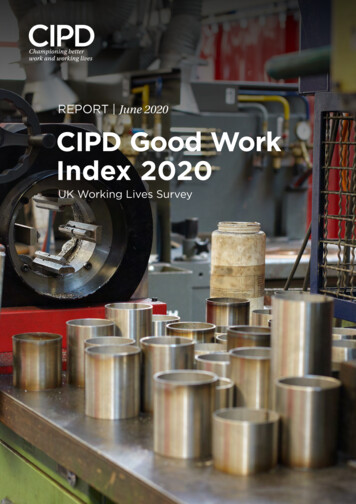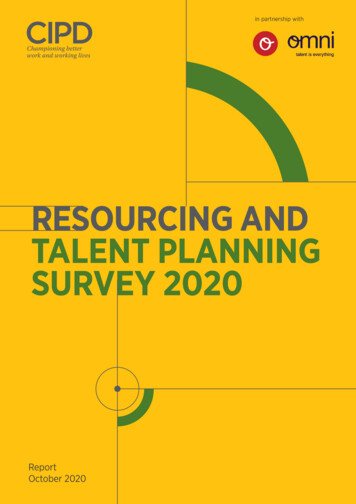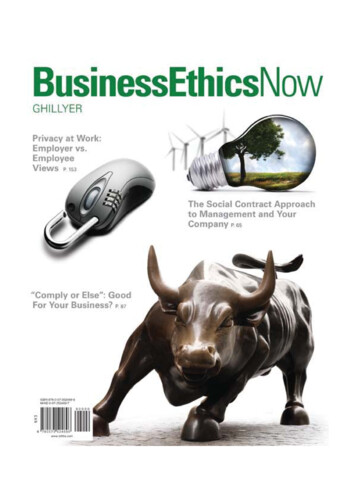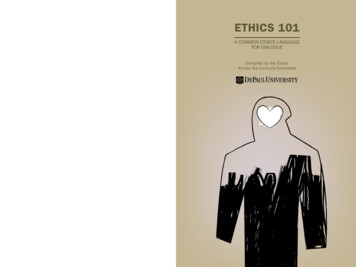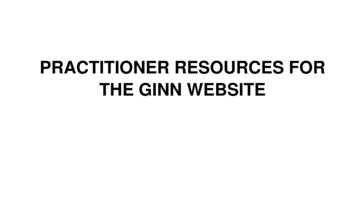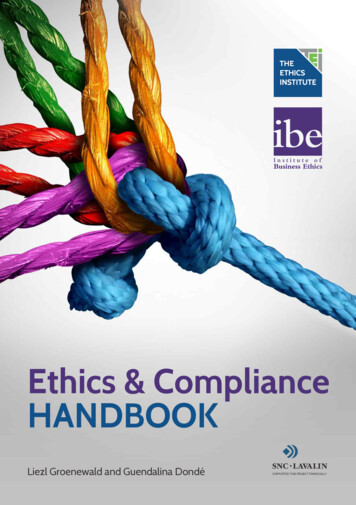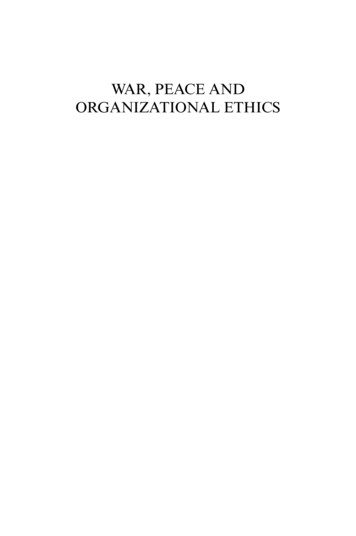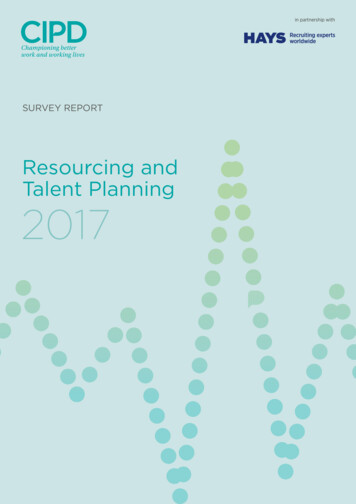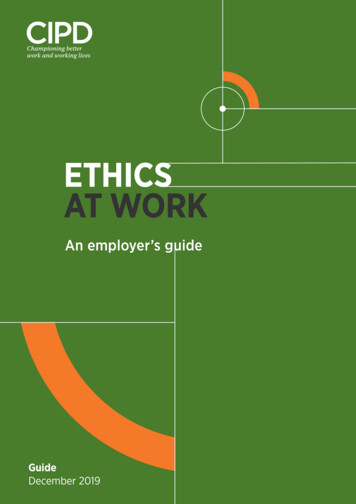
Transcription
ETHICSAT WORKAn employer’s guideGuideDecember 2019
The CIPD is the professional body for HR and peopledevelopment. The not-for-profit organisation championsbetter work and working lives and has been setting thebenchmark for excellence in people and organisationdevelopment for more than 100 years. It has more than150,000 members across the world, provides thoughtleadership through independent research on the world ofwork, and offers professional training and accreditation forthose working in HR and learning and development.
Ethics guideGuide1234Ethics at work:an employer’s guideContents1Introduction 22Ethical climate in organisations 43Develop and consistently embed codes 64Fairness and organisational politics 85Personality/mood 106Job design 127Targets and reward 148An alternative to silence: whistleblowing/speaking up 169Accountability 191010Communication 21Conclusion 23111112Appendices 2413Further resources 14References 3356789121314AcknowledgementsThis guide was written by Tina Russell and Ally Weeks (CIPD), based on a broadreview of published research and other materials.We would also like to thank our colleagues who provided their support and friendlycritique in preparation of this work: Jonny Gifford, Melanie Green, Katy Adalar, HollyIvins and Derek Tong (CIPD) for their editorial contribution, and Guendalina Donde,Institute of Business Ethics, for her review.132
Ethics guide12345678910111213141IntroductionEthical values provide the moral compass by which we live our lives and make decisions:‘doing the right thing’ because it’s the right thing to do, not because of personal orfinancial gain. They also highlight why organisations should focus on creating a sharedethical culture where employees feel empowered to do the right thing rather than simplyfollowing a set of rules.The way we make decisions is important for organisations because the wrong decisions– or decisions which have been implemented badly – can have a significant impact onpeople’s lives and the reputation of organisations. But when we make decisions basedon good principles, and live by good values, we can improve the lives of others, theexperiences they have at work, and make work more meaningful.In setting out standards for the people profession, the CIPD’s new Profession Map1 includesethics under ‘Core behaviours’ and describes ethical practice as:‘Building trust by role-modelling ethical behaviour and applying principles and valuesconsistently in decision-making.’Therefore, it’s vital that people professionals can define ethical behaviour, identify unethicalbehaviour, and take steps to create a shared ethical culture which avoids this type ofbehaviour.What do we mean by unethical behaviour?Unethical workplace behaviour can vary from minor transgressions to illegal activity, butare essentially actions that harm the legitimate interests of the organisation, its workforce,customers and wider society. Examples include (but are not limited to): theftfrauddeceptionbullying and harassmentsabotage.This behaviour could result in absenteeism, tardiness, rule-breaking, disengagement,defensive outbursts, and could lead to an increased attrition rate amongst those affectedby such unethical behaviour.Other examples of unethical behaviour may be where the advancement of financialgain, such as price-fixing, putting profit above safety, withholding vital information, andmisrepresenting facts, is inherent in the workplace. These actions may not necessarilybe illegal, but it can be unethical to engage in or encourage this type of behaviour;organisations must deal with the risk of such behaviour becoming custom and practice,and work to emphasise the importance of ethical behaviour when pursuing financial gain.To reduce unethical behaviour, people professionals should consider working life in generalto understand why unethical behaviour may arise: it could be toxic work environments/climate and culture, poor leadership, power struggles or inequality. Social influence andexposure to dishonesty could trigger indefensible behaviour (such as consistently settingover-stretching [un-agreed] goals and unrealistic time pressures). In their Ethics at WorkSurvey,2 the Institute of Business Ethics (IBE) found that other causes can be pressures feltby the workforce. We’ve written this guide to help employers mitigate for these situations.2Introduction
Ethics guide1234567891011121314Upholding professional conduct by CIPD membersThis guide is relevant for any employers or managers interested in learning how tofoster ethical behaviour in their organisations. In addition, as a professional body,the CIPD also sets standards and guidance for the people profession. All members ofthe CIPD are required to adhere to the Code of Professional Conduct, which sets outexpectations of members: Code of Professional Conduct.3 Potential breaches of theCode may be investigated, and if a breach is upheld by a Conduct Panel, a membermay face a range of sanctions, including expulsion of membership or publication ofcase details: Code of Conduct Cases.4In 2018–19, 77 complaints about alleged breaches of the Code were received, up 55%on the previous year, including an increasing number of complaints regarding: social media conduct by members conflicts of interest.How this guide can helpThis guide draws on and complements recent CIPD research reports and features nineareas of action employers can prioritise to ensure they are behaving ethically. The areasare based on the CIPD’s research report, Rotten Apples, Bad Barrels and Sticky Situations:A review of unethical workplace behaviour.5 The research explores the factors that influenceunethical and ethical workplace behaviour to highlight where businesses should take action.There are several reasons why unethical behaviour happens in the workplace. The ‘rottenapples’ (individual actions and choice), the ‘bad barrels’ (organisation or industry-wideindiscretions) and the ‘sticky situations’ (potentially compromising decisions) peopleface all play a role. In this guide, we discuss ‘red flags’ to watch out for, followed up withpractical tips on ‘what you can do’ to make change or redress the balance. These tips serveto help safeguard your businesses and the people within your organisation.‘Early on one often heard the explanation, “well it’s just a few bad apples”. I think it is notjust a few bad apples, it is the barrel in which they are operating, and we need to fix thebarrel as well as tracking down the bad apples.’ Michouce Shafik, the Deputy Governorfor Markets and Banking, Bank of England6OxfamOxfam experienced significant reputational damage following the revelation that adirector of operations in Haiti is alleged to have hired prostitutes at a villa rentedfor him by the charity. Oxfam were accused of a cover-up, despite saying that ituncovered the accusations in 2011 and immediately launched an internal investigation.Four members of staff were dismissed and three, including the director of operations,were allowed to resign before the end of the investigation. Oxfam did not warnother aid agencies about these problem staff. Further allegations then arose aboutoperations in Chad.The fallout unfolded as follows: The Charity Commission opened a statutory inquiry – the most serious action itcan take. The European Commission threatened to cease funding.3Introduction
Ethics guide1234567891011121314 Oxfam agreed to stop bidding for UK government funding until it can show itmeets the ‘high standards’ required. The Haiti Government launched an investigation. Actress Minnie Driver stepped down from her role as an ambassador for thecharity, followed by Archbishop Desmond Tutu. Deputy Chief Executive Penny Lawrence resigned. Oxfam published a redacted version of its 2011 report and revealed three ofthe accused men physically threatened witnesses during the charity’s 2011investigation. Senior executives were called to speak to MPs and confirmed that 7,000 peoplehad cancelled donations and that 26 claims of sexual misconduct have been madesince the scandal broke.2Ethical climate inorganisationsA growing number of companies have recognised that ethicalpractice and corporate social responsibility policies yield greateremployee commitment and motivation, enhanced customer loyalty, minimised risk, and anenhanced brand. This in turn will attract talent to the organisation and should positivelyimprove (reduce) labour turnover as well as positively impact on employee relations andrelationships with unions. According to the Institute of Business Ethics (IBE), some studiesshow that being ethically responsible helps companies develop new competencies becauseit engages employees by calling for forward thinking.Ethical climate refers to the social norms and values that outline what ‘the right behaviour’is and how ethics should guide behaviour. Norms can be reflected and reinforced by formalprocesses (for example, disciplinary processes and reward) and informal processes (suchas leadership behaviour). Climate is affected by events, which means it can change rapidly.Climate is also linked to job satisfaction and employee well-being.‘A climate can be locally created by what leaders do, what circumstances apply, andwhat environments afford. A culture can evolve only out of mutual experience andshared learning.’ 7 Edgar ScheinEthical contextAll organisations have an opportunity to influence their ethical climate and to encouragethe workforce to act and behave in an ethical manner. People may be driven to behave ina particular way by their organisational climate, and perceptions of ethical leadership havebeen found to positively impact ethical behaviour by employees.When considering ethical climate (and determining how to influence your organisation’sethical climate), there are three key types of ethical climate to be aware of: Egoistic/instrumental: Acting in self-interest is the norm; people protect theirown interests, including putting company profit above other considerations andthe consequences of actions. This climate is associated with unethical choices anddysfunctional behaviour.4Ethical climate in organisations
Ethics guide1 Benevolent: Acting in the interest of others, the workforce is actively concerned aboutthe customers’ and public’s interest and negatively connected with unethical choices. Principled: Sticking to rules and regulations is the norm and there is a reduction inunethical choices and dysfunctional behaviour.2Honestly identifying the type of ethical climate that currently exists in your organisationwill help in taking steps to improve the ethical climate.3Red flags The organisation’s business model is fostering unethical behaviour; for example,prioritising profit over the impact on customers and the wider community. Shortcuts are taken that may detrimentally affect stakeholders or the wider community(a sign of an egoistic climate). The level of trust within and outside of the organisation from staff and customer surveysis low (this may identify a perception of egoistic climate as opposed to the benevolentor principled perception that an organisation may assume exists). How competition is dealt with and perceived externally is a clear sign of an egoistic climate. No effort is undertaken by leaders to foster active participation in strategy development,business activities and innovation. There is high staff turnover. Insights in exit interviews flagging coercive management,disputes over pay or other issues are indicators of an egoistic climate. The types of grievances raised may provide an indication of the type of ethical climateprevalent in the organisation. Infrequent or low participation on platforms for raising concerns, such as staff surveysand representative groups, could mean a lack of employee confidence that there wouldnot be reprisals for feedback. Financial transactions (such as paying suppliers late) can be an indicator of financialstress and an egoistic climate. What is the level of understanding of differences across international territories andcultures and do the organisation’s values translate internationally? If considered to below, it would jeopardise a principled climate. Are policies and processes fit for purpose? Sticking to rules and using checks andapproval processes would be indicative of a principled climate (however, it’s worthchecking that the appropriate balance is struck and that bottlenecks are not caused).45678910111213145No-frills airline mass flight cancellation fiascoThe Irish Aviation Authority ordered Irish-based airlines to comply with flight timelimitations for their pilots. Due to a management and scheduling faux pas, one suchno-frills airline didn’t plan for this regulation until it was too late. 20–40 flights per daywere cancelled over a three-month period in 2017, affecting 700,000 passengers. Pilots(who were encouraged to take month-long holidays between October and March toavoid the busiest times) were told to buy back or forego their holiday entitlement untilthe following year, claiming the firm could do this without workforce agreement orconsultation. Customers were initially offered a 40 voucher as compensation (whichdoes not conform with EU rules governing flight cancellations); however, this airline waseventually forced to offer affected passengers the minimum dictated by the regulators.This form of unilateral decision-making by senior leaders has led to passenger distrust,many pilots moving to different airlines, a massive dent to reputation, and the airlinehas had to at last recognise union representation.8 This airline has now taken steps torebuild trust by reconstructing their employee value proposition (EVP).Ethical climate in organisations
Ethics guide1234567891011121314What you can do To start, look at where the balance lies in the organisation between shareholder primacyand wider stakeholder interests. Explore (and agree) the accepted organisational norms within the workforce and theethical considerations of their work, including behaviours. Agree how these will bemeasured and monitored. Consider how leadership, management and HR practices shape the ethical climate. Use internal communications to encourage high ethical standards and ensure that thevalues and/or code of ethics are not in contrast to the climate. Cascade regular moral reminders in newsletters and business updates confirming notonly the ethical expectations, but also reaffirming the leadership support to upholdthose values. Ensure there is a triangulation of available evidence to support workforce-basedrecommendations and management. Regularly extrapolate important insights from allstakeholders and agree critical indicators. Monitoring behaviour has been found to reduce unethical behaviour and draws attentionto the individual’s moral standards and awareness. Balance this with engendering trust. Commit to – and deliver – inclusion across the organisation in order to achieve either abenevolent or principled climate.See Appendix 1 for a checklist on how to address the ethical climate in your organisation.3 evelop and consistentlyDembed codesA code of conduct sets out the actions and behaviours required of theworkforce. It may be supported by disciplinary procedures that will beinvoked in the event of a failure to uphold the code of conduct, so it is typically more of acompliance requirement and likely to be more directive.A code of ethics, on the other hand, sets out the values and/or principles of anorganisation (and may include aspirational aspects).A ‘principle’ is a truth that is the foundation of a belief system. It is consideredobjective and unchangeable. A ‘value’ is a person’s personal belief for or againstsomething, able to change and subjective.Both types of code are applications of normative ethics (the study of ethical action), whichis concerned with the ‘oughts’ of ethical behaviour. A code of ethics may be used as a guideto inform decision-making and exemplify what ethical practice looks like, rather than actingas a tool for compliance and enforcement – that is better suited to a code of conduct.For this guide we refer to a code of ethics rather than a code of conduct.The beliefs of the organisation expressed through values and/or a code of ethics must becredible and echoed by the board, leadership and management. This endorsement is vitalto embedding ethics in the organisation and needs to be communicated regularly.6Develop and consistently embed codes
Ethics guide1234567891011121314Ethical contextTackling the causes of unethical behaviour should be a priority for businesses. Theexistence of a code will not guarantee ethical behaviour and choices. A code shouldnot be something that only sits in a drawer or on the intranet. The values and principlesthat underpin the code should not only be understood but shared by the workforce andadopted as the way to do business. The code should therefore be clear on what customers,stakeholders and the remaining workforce can expect from individuals and from eachother. Codes must be actively enforced to promote ethical behaviour, and unethicalbehaviour must be tackled consistently across the organisation regardless of status or theindividual. Checks and balances should identify all blind spots and any inaction.A multinational energy company reported in their 2018 sustainability report that 50employees had been dismissed for non-conformity with their code or for unethicalbehaviour. The organisation trains its workforce on how to apply their code in theirdaily work. In 2018 this training focused on raising awareness of workplace harassment,conflicts of interest and protecting confidential information.9Red flags If your organisation operates internationally, a code of ethics or rules may not beapplicable in certain territories (for example, use of gifts and entertaining). This mayresult in disengagement with the principles by internationally based colleagues. There is a lack of awareness or understanding in the workforce of the ethicalramifications of an action, behaviour or decision. Boards and stakeholders find it difficult to assess whether any codes are effective. The workforce needs to be regularly asked if they have read and understood the code.What you can do To be fit for purpose, the code should be easy to read and translate into practice by allstakeholder groups. Avoid jargon, legalese and vague statements. Watch out for the tone taken within the code and with communications about the code.Beware of being excessively strict on the workforce so they do not start hiding issues. It may seem obvious, but make clear whether the code is mandatory, including theramifications of failure to adhere to the code. Metrics should be agreed between the board and leadership to measure theeffectiveness of a code and to identify patterns that suggest action that can be taken. Find a way to balance taking action and raising concerns with a ‘no-blame’ culture (bearin mind that this will differ between companies). The code should be a reference document, but should not be built to stand alone; it must besupported with auxiliary materials (for example, decision-making frameworks, policies and processes). Individuals who are promoted should be clear role models of the organisation’s code.An international corporation was informed by the Centres for Disease Control thattampons were a potential contributor in ‘toxic shock syndrome’. Initial work had notshown a relationship with their product, but despite this, the organisation withdrewtheir product three days later at significant cost as well as funding an educationprogramme to inform the public about the syndrome. In this case, honesty and riskmanagement were prioritised over burying reputation-damaging information.10See Appendix 2 for a flowchart on how to develop and consistently embed codes.7Develop and consistently embed codes
Ethics guide123456789101112131484 Fairnessandorganisational politicsOrganisations that treat their workforce with fairness, integrity andsensitivity are more likely to find that the workforce responds withincreased commitment and productivity.11Ethical contextThe workforce is more likely to act unethically when they perceive their organisation to beunfair; for example, if reward or resources aren’t shared fairly, or policies and proceduresare inconsistent.This is also the case when organisational politics are widespread; feeling that you must‘watch your back’ and that your success at work depends on more powerful ‘others’ canresult in employees losing focus on carrying out their role conscientiously. The effortrequired to navigate organisational politics can create a strain, reduce self-determinationand intrinsic motivation, causing a reduced sense of relatedness and increasing alienation,resulting in unethical behaviour and in people protecting their own interests aboveother ethical considerations.12 Fear and frustration also play a role, leading to unethical,counteractive work behaviour such as disengagement and withdrawal of work effort,lateness, taking longer breaks and generally favouring the path of least resistance.Take the psychological contract (the mutually implicit expectations of the workforceand employers towards one another) as an example. If employees feel that promisesare broken, removed or changed, they might experience deep feelings of unfairness,dissatisfaction and loss of trust. Outward signs of such feelings could manifest in seeingthe following red flags:Red flags rising numbers of grievances (both officially in writing and unofficially where mediationcan help to resolve the situation) spikes in absenteeism (especially for employees where this might be deemed out ofcharacter), poor performance, incivility, attrition rates and extended sick leave surveys revealing that employees have rising distrust in leaders, experience unreasonableorganisational politics, and feel that promotional opportunities only favour the few disparity of pay favouring men – despite this being unlawful since the Equal Pay Act1970,13 the need for gender pay gap reporting from April 2017 shows this is still prevalentin some organisations unfair allocation of work within a team (causing stress for some and an easy life forothers) misuse of non-disclosure agreements (NDAs) – confidentiality clauses are used in twokey ways: within wider contracts of employment or within settlement agreements.There are already legal limitations on such clauses, but evidence suggests a minority ofemployers are using them to intimidate victims of harassment into silence. Allegations ofdiscrimination should be investigated properly and fairly as per your grievance policy.Fairness and organisational politics
Ethics guide1234567891011121314In 2018 the New York Times reported that HR departments are ill-equipped toinvestigate discrimination complaints and, in some cases, have hidden abusiveleadership behaviour. Women working at a leading retail sports outfitter’s USheadquarters complained to HR about sexual harassment and demeaning treatmentby male supervisors, who used vulgar and condescending behaviour towards them.The culture has been described as toxic and pre-disposed to promoting men overwomen, regardless of behaviour or complaints. One manager received promotion to anexecutive role despite having three grievances on file brought by three female directreports. It took an anonymous survey to trigger an internal investigation and a majorshake-up in the company’s top ranks.14What you can do People deserve to be treated fairly and have a meaningful voice on matters that affectthem (in addition to their rights and protection under law). People professionals shouldnot assert or distort the balance of power; they should strive towards positive outcomesfor the workforce (like well-being) as well as the business (like profit and loss) in equalbalance. Don’t let short-term business outcomes lead to decision-making that could be deemedunfair and be detrimental to the business in the long run. Assess employee perceptions of politics and fairness through surveys and focusgroups. Ensure they are transparent, and communicate what you are doing to makeimprovements based on the feedback. Review policies and practices to ensure they are fair and unbiased. Consider the fairnesslens for everyone in the workforce: if it could cause a detriment to an under-representedgroup, it is unfair. Keep political behaviour (such as ambiguous decisions or promoting favouredemployees) in check, challenging it when it becomes unhealthy. Have clearly defined values and behavioural competencies, role-modelled by leaders. Ensure development opportunities are extended for the entire workforce, not just theexclusive few. Work with managers to ensure that work is allocated fairly within teams, with equalopportunity to be involved in stretching projects. Build inclusive organisations that treat people fairly and respond to diverse voices.15 Advocate consistency in performance management. It should be regular and offerfeedback that motivates the workforce, helps them improve, and holds them to account. Review NDAs to ensure they don’t prohibit an employee from bringing a genuineunlawful act to be investigated. Allegations of discrimination or harassment should beinvestigated properly and fairly in line with your grievance policy.A global pharmaceutical corporation has a ‘promote from within’ policy which appliesworldwide, and means that senior leadership roles are given to existing members of theworkforce.9Fairness and organisational politics
Ethics guide1234567891011121314105Personality/moodCertain personality factors (which include an individual’s characteristicpatterns of thought, emotions and behaviours), along with theirpsychological attributes, can lead to unethical behaviour.16 Therefore,understanding personality traits of individual staff, and building in measuresto steer the likely courses of behaviour, will be important considerations in creating ethical practice.Ethical contextThe ‘dark triad’ personality traits17 (Machiavellianism, psychopathy, narcicissm) can be a riskfor organisations and can manifest in employees being manipulative, displaying impulsivityand lack of remorse, and being cynical towards others. Machiavellian traits can mean peopleare more likely to behave unethically; for example, by committing fraud or acting in waysthat benefit themselves over other stakeholders and using the ends to justify the means.‘Some of the characteristics you see in psychopaths are lying, manipulation, the abilityto deceive, feelings of grandiosity and callousness toward their victims.’ Gregg O.McCrary, a former special agent with the FBI who spent years constructing criminalbehavioural profiles18It’s important to bear in mind that, while personality describes relatively permanentaspects of an individual’s psychology, there are factors influencing unethical behaviourthat we have no control over. Remember that people with these personality traits will notnecessarily be unethical, and the role for people professionals is to work to mitigate anyrisks posed by these personality traits.Red flags Competitive individuals are more likely to sabotage or misrepresent work. This trait ismore pronounced when these individuals have information on the performance of others. High levels of egocentrism are shown by self-focus and employees advancing their owninterests with little concern for how their actions impact others. Greed will be shown by someone making social comparisons which can motivate actionsto increase their wealth, and by optimising results or outputs for their benefit. Feelings of social exclusion can affect those with a need to be included in a group. High levels of impulsivity indicate less willpower or self-control. For example, pyramidschemes demonstrate the human capacity to focus on immediate payoffs whilediscounting future detection and punishment.19 High levels of moral relativism – where moral principles are context-specific orsituationally determined; people with this trait can therefore feel that harm to othersmay be justified. Those with high levels of happiness may be prone to passively follow pressures toengage in unethical behaviour to sustain their happiness or take the path of leastresistance. This was exemplified by the associates that were highly remunerated torecruit clients for Bernie Madoff, who orchestrated an elaborate Ponzi scheme. Despitehaving some reservations, the associates did not take action.20 Dark personality traits:21 Machiavellianism; narcissism; psychopathy; manipulation; selfbeneficial behaviour; shown by those who take an ‘ends justify the means’ approach andare prepared to violate social norms and commit fraud. Be aware when personality is overly attributed as a cause for behaviour – for example,a late colleague being considered as tardy (person based) rather than faulting factorssuch as transport (action based).Personality/mood
Ethics guide123456789101112131411 Blame is used to rationalise unethical behaviour (also found when individuals negativelyfeel an external locus of control [the degree of autonomy in their work]). Absence, lateness, staff exits, complaints, over-budget project delivery or failure todeliver/under-selling of products and services/sabotage or withdrawal can be signs ofpersonality-related matters; these may be caused by low self-esteem, stress or negativeemotions such as anger, guilt, lack of job satisfaction, or a sense of unfairness. The extent to which the performance management process is dependent upon aprescribed set of behaviours – some personalities are more prone to behave in a particularway; there should be reflection of this and flexibility in the expectations of the workforce. Temporary ethical blindness – a subconscious state in which a person is unable to seethe ethical dimension of what
The CIPD is the professional body for HR and people development. The not-for-profit organisation champions better work and working lives and has been setting the benchmark for excellence in people and organisation development for more than 100 years. It has mor


